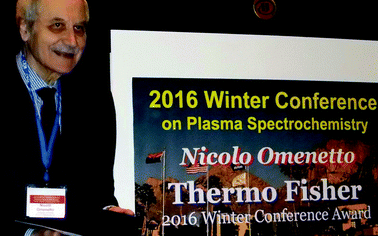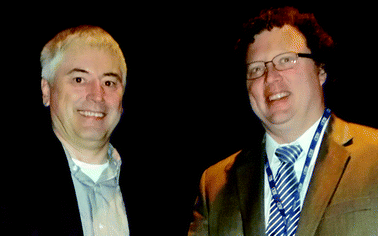2016 Winter Conference on Plasma Spectrochemistry, Tucson, Arizona, January 11–16, 2016
Ramon M.
Barnes
ICP Information Newsletter, Inc., Hadley, Massachusetts, USA
According to Petra Krystek, VU University Amsterdam, “More analytical approaches are needed to characterize and analyze nanoparticles in a variety of matrices, and new developments in the technical field of ICP-MS fit well to this research. The most relevant aspects are the single particle ICP-MS possibilities and further developments with hyphenated techniques like field-flow-fractionation (FFF) coupled to ICP-MS.”
Gary Hieftje, Indiana University, commented: “It is clear that laser ablation and LIBS have both moved into the realm of routine, robust tools for elemental and molecular analysis, and that new uses and approaches continue to be introduced.”
Gary Meyers, Promerus LLC, noted: “I was especially appreciative to hear that developments are still continuing with optical emission spectrometry as detectors for ICPs and glow discharge plasmas, and that these tools continue to have a significant impact in present day metals analyses.”
Patrick Parsons, New York Department of Health, remarked after the Workshop on Biological and Clinical Sample Methodology: “This workshop continued the practice of bringing together practitioners using ICP-MS to solve problems in the clinical and biological sciences and covered a broad range of subjects and applications, and featured imaging techniques as well as newer approaches to inorganic mass spectrometry based on tandem ICP-MS/MS.”
Considering the symposium on marine and geological sciences, Klaus Peter Jochum, Max Planck Institute for Chemistry, observed: “MC-ICP-MS has become a widespread method for high-precision isotope analysis for elements ranging from Li to U.”
Unique to the Winter Conference were 5 Heritage Lectures (Table 1) presented by senior scientists, who reflected on significant developments in the field. The death of Professor Joseph A. Caruso was remembered by colleagues during a memorial symposium in which Professor X. Chris Lee, University of Alberta, described recent developments in arsenic speciation and studies of arsenic metabolism and health effects.
| HL01 Tools of the Trade—From Flow Injection to Laser Ablation, Alan G. Cox and Cameron McLeod, University of Sheffield, Centre for Analytical Sciences, Department of Chemistry, Sheffield, United Kingdom |
| HL02 The Boundary Conditions for Scientific Research, Kay Niemax, BAM – Federal Institute for Materials Research and Testing, Department 1: Analytical Chemistry and Reference Materials, Berlin, Germany |
| HL03 49 Years of Atomic Spectroscopy—From Nebulizers to Detectors—Time Marches On, M. Bonner Denton, University of Arizona, Department of Chemistry and Biochemistry, Tucson, Arizona |
| HL04 Innovative Research on Plasma Spectrochemical Methods for Solving Analytical Problems, José A. C. Broekaert, University of Hamburg, Department of Chemistry, Hamburg, Germany |
| HL05 ICP-MS From the Eye of a Beholder Part II, Robert S. Houk, Iowa State University, Department of Chemistry, Ames Laboratory USDOE, Ames, Iowa |
For the 4th time since 2010 an award sponsored by Thermo Fisher Scientific was presented to Nicoló Omenetto, University of Florida, for his outstanding lifetime achievements. A new award, also sponsored by Thermo Fisher Scientific, intended to recognize a young scientist who has made noteworthy contributions to the field of plasma spectrochemistry, was introduced and presented to Steven Ray, SUNY Buffalo. In his award lecture Ray stressed that many strong reasons exist to be optimistic about the future of plasma spectrochemistry. Both award presentations were followed by symposia featuring invited contributions from contemporaries. Gary Hieftje commented: “It is clear that the future of plasma spectrochemistry is in good hands.”
Nicolo Omenetto receiving his award from Lothar Rottmann
Steven Ray receiving his award from Lothar Rottmann
Twelve outstanding poster presentations also were recognized with book awards from the Royal Society of Chemistry, JAAS, and other science publishers. Five plenary lectures (Table 2) initiated the program each day, and 36 invited lectures complimented by contributed papers targeted selected research progress in each symposium. Details of the contributions are available elsewhere.1
| PL01 Nanoparticles in the Environment: Analytical Strategies for Identification and Quantification, Frank von der Kammer, Stephan Wagner, Jana Navratilova, Antonia Praetorius, Alexander Gundlach-Graham, Thilo Hofmann, et al., University of Vienna, Department of Environmental Geosciences, A-1090 Vienna, Austria |
| PL02 Recent Developments and Advances in the Theory, Instrumentation and Applications of Laser-Assisted Plasma Spectrochemistry, Nicoló Omenetto, University of Florida, Department of Chemistry, Gainesville, Florida |
| PL03 Advances in Plasma Spectrochemistry, Gary M. Hieftje, Indiana University, Department of Chemistry, Bloomington, Indiana |
| PL04 Bioanalytical Tools to Address the Clinical Implications of Using Iron-Nanoparticles for Therapeutic Applications, Maria Montes-Bayón, J. Garcia Fernández, D. Turiel, J. Bettmer, N. Jakubowski, A. Sanz-Medel, U. Panne, University of Oviedo, Department of Physical and Analytical Chemistry, Oviedo, Spain |
| PL05 In situ Isotope Ratio Measurements Using Multiple Ion Counting ICP-MS Coupled with Laser Ablation, Takafumi Hirata, Kyoto University, Kyoto, Japan |
| ML01 Speciation Analysis and Studies of Arsenic Metabolism and Health Effects – A Tribute to Professor Joe Caruso, X. Chris Le, Qingqing Liu, Hanyong Peng, Baowei Chen, Chungang Yuan, Xiufen Lu, Xing-Fang Li, Analytical and Environmental Toxicology Division, Department of Laboratory Medicine and Pathology, Faculty of Medicine and Dentistry, University of Alberta, Edmonton, Alberta, Canada |
More than 100 individuals enrolled in one or more of the 43 preconference professional development short courses taught by spectrochemical experts, many of whom also delivered invited lectures. This short course program introduced in 1986, continued the special tutorial nature of the Winter Conference. The topics offered advanced and introductory training in popular plasma techniques and spectroanalysis methods as well as novel development areas.
With these statistics in mind, the question of the number of “wow” moments arise, and most participants agreed that plasma spectrochemistry is solving problems and stimulating new research in analytical, bioanalytical, environmental, ecotoxicological, marine and geo-chemistry. The Winter Conference tradition continues in 2017 with the next European Winter Conference on Plasma Spectrochemistry, February 19–24, in Sankt Anton, Austria, and the 7th Asia-Pacific Winter Conference on Plasma Spectrochemistry, in Matsue-City, Shimane, Japan, November 12–17. The 2018 Winter Conference will return to Amelia Island in Florida, January 8–13. Thus, the Winter Conference continues to be a success against competition from other conferences.
References
- ICP Inform. Newsl., 41(9), 1139–1362, February 2016.
| This journal is © The Royal Society of Chemistry 2016 |



